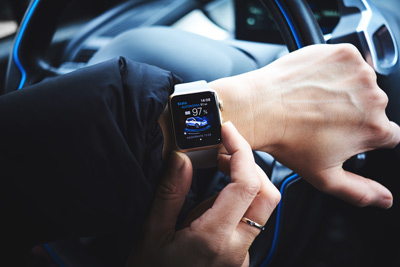NFC technology brings security to smart devices
INTERNET OF THINGS FOR YOUR EVERYDAY LIFE
 People have responded incredibly well to the smart devices market with sales skyrocketing in 2014. Sales of e-wristbands went up by an astonishing 684% in the second trimester, and the entire Internet of Things market continued to grow strongly throughout 2015. However, the numbers fell slightly short of predictions made by analysts.
People have responded incredibly well to the smart devices market with sales skyrocketing in 2014. Sales of e-wristbands went up by an astonishing 684% in the second trimester, and the entire Internet of Things market continued to grow strongly throughout 2015. However, the numbers fell slightly short of predictions made by analysts.
Today, all the smart devices sold in the top 5 are objects worn on the wrist. But the body is such a huge field of potential innovations for this kind of technology. Future will bring us many more products such as connected clothes, shoes, etc. The expected increase concerning smart devices is absolutely amazing, especially for a culture obsessed with measuring and quantifying their body every day.
WILL TOMORROW THIEVES BE HACKERS ?
Between gadgets and medical devices, the service provided is very braod. And -certainly in the first cas- the need for data protection is not perceived as urgent. About 11% of French people owned a smart device related to health and wellbeing; the glycemic reader remains to be the main product sold on the medical smart market. In this case, its use is regulated and data protection is a real demand since medical confidentiality is involved.
Obviously, smart devices don’t only concern health and wellbeing fields but also all the aspects of home life. And once again the expectation of data protection is strong.
But why would it be interesting to know about someone’s heat, intrusing warning system, and opening/closure front door settings ? Because they show evidence of someone is in or not and of the possibility to break into the house. The slightest security breache in someone’s smart-devices-network exposes us and makes us vulnerable to any kind of hostility.
Ensuring security in the Internet of things
In everyday life, anyone want to be sure that his personal data used and registered by connected things are safe, and that the connected things themselves can’t get hacked. But above all, anyone wish this security to be invisible and not to make life more complicated because of passwords to remember.
From their part, equipment manufacturers don’t want to be pointed if a product comes to get hacked. And brands have to get it right otherwise their image will suffer.
The Internet of Things is probably the begining of a new economic phase. Frameworks will gradually be defined, but questions of costs related to security are already put forward and impacts in terms of image for brands seems to be major.
A cryptographic software stack seems not to be sufficient because of all the examples of security breaches in softwares.
The major step towards a strong security then begins with secured modules, providing strong authentication and protection. The NXP A70CM module answers all these needs.
 MARIE-ANTOINETTE AND THE NECESSITY OF AN OUT OF-BAND CHANNEL
MARIE-ANTOINETTE AND THE NECESSITY OF AN OUT OF-BAND CHANNEL
From June 1791 to August 1792, Marie-Antoinette fed the flamme of a passionate correspondance with a young Swedish officer. Their letters were encrypted with a complex “polyalphabetic” code. Two elements are necessary to decrypt the letters - a decrypting table and a keyword. The keyword is the only word for which the table is used and it changes with each letter.
Of course, only Marie-Antoinette and the officer were privy to the keyword, and to avoid anyone else stumbling accross it, the keyword was sent in a different manner to the letters. To this day, we don’t know how they sent the keyword but theories range from it being hidden in hat seams to being smuggled in pieces of furniture.
IS NFC TECHNOLOGY THE BEST TECHNOLOGY FOR PROTECTING SMART DEVICES COMMUNICATION?
NFC (Near Field Communication) is a wireless communication technology which main asset in this case is its short communication distance (till 10cm). This would point to NFC technology to be the best way to communicate the equivalent of the keyword of Marie-Antoinette’system explained above. And then it would be the security keystone of smart-devicesnetwork. A short communication distance means indeed that nobody can intercept data without being identified.
It may be so in theory, but in an upcoming article, we will see how pratice turns upside down the theory.